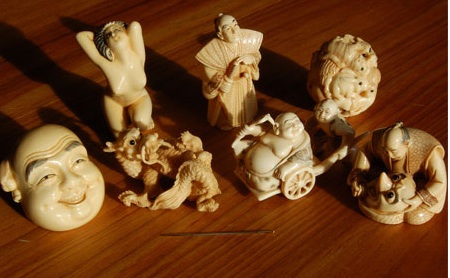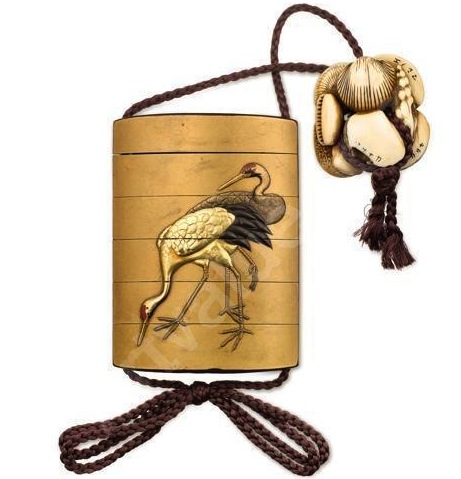A netsuke is a form of miniature sculpture which developed in Japan over a period of more than three hundred years. It served both functional and decorative purposes.
 The kimono, the traditional form of Japanese dress, had no pockets. Women would tuck small personal items into their sleeves but men suspended their tobacco pouches, pipes, purses or writing implements on a silk cord from their obi (kimono sash).
The kimono, the traditional form of Japanese dress, had no pockets. Women would tuck small personal items into their sleeves but men suspended their tobacco pouches, pipes, purses or writing implements on a silk cord from their obi (kimono sash).
These hanging objects are called sagemono. To stop the cord from slipping through the obi, a small toggle was attached. The toggle is called a netsuke.
A sliding bead (ojime) was strung on the cord between the netsuke and the sagemono to tighten or loosen the opening of the sagemono.
The entire ensemble was then worn, at the waist and functioned as a sort of removable hip pocket.
All three objects (the netsuke, the ojime and the different types of sagemono) were often beautifully decorated with elaborate carving, lacquer work, or inlays of rare and exotic materials, including: wood, ivory, precious metals, shell, coral, and semi-precious stones.
It is believed that netsuke were made from ivory. However, only about a half of all netsuke are ivory. Netsuke carvers used materials that were available.
Only artists located in Osaka, Kyoto, and Edo (Tokyo) had access to ivory. Artists outside of these population centres primarily used box or cherry wood, which they stained and polished.
 However, nearly every material imaginable was used, including narwhal (marine ivory), boar’s tusk, amber, stag antler, pottery, bamboo etc.
However, nearly every material imaginable was used, including narwhal (marine ivory), boar’s tusk, amber, stag antler, pottery, bamboo etc.
All these items developed into highly coveted and collectible art forms.
Japanese people used to hang their everyday articles such as small money pouches, tobacco pouches, and seal or medicine cases (inro) from their sash or belt (obi), because the Japanese traditional garment (kimono) has no pockets. To prevent it falling to the ground, the hanging object(s) (collectively called sagemono) was attached to a small toggle with a cord, and the toggle is called netsuke.In general, the netsuke has the following physical characteristics or requirements:
- To serve as a toggle attached to hanging objects, it has a hole or a channel (himotoshi) to put the cord through.
- To be worn as an accessory or held in hands, it doesn’t (or shouldn’t) have parts that can easily be broken or might catch the garment.
- To be worn at the waist, it is comparatively small. It is generally about as large as you can hold in your hand, but it could be a bit smaller or larger than that.
In early times, netsuke flourished as a part of the ensemble with a small pouch and/or an inro and cord-tightening bead (ojime). Nowadays, many netsuke are exhibited, traded, collected as independent objects, but they were originally attached to sagemono, some sets of which you might also see in museums, private collections, galleries, and publications.
History of Netsuke
It is not clear as to when netsuke came into use, but some netsuke are depicted in paintings from around the beginning of the 17th century, suggesting that the netsuke was already in use by then.
Though first netsuke were probably simple pieces of wood or whatever was useful as a toggle, it developed into a craft art with great artistry and playful ideas through the Edo period (i.e., from the early 17th century through the mid 19th century). Netsuke in a considerably wide range of subjects and materials were made by thousands of artists; early craftsmen specializing in other fields such as metalwork or sculpture and made netsuke as a hobby, while many of the later carvers devoted all their career to netsuke production.
However, around the mid 19th century, the popularity of netsuke started to wane due to the changes in fashion and cultural situations. A relatively small number of netsuke artists continued to create netsuke of high standard through the mid 20th century.
From the mid 19th century onwards, westerners became interested in netsuke. A large quantity of those miniature carvings began to be exported to the West. Since then, netsuke have been actively traded, collected, and studied by westerners, while they attracted little attention of the majority of Japanese people.
Netsuke made until about that time are called “antique netsuke,” while those carved later are referred to as “contemporary netsuke.” This latter term means more than just “netsuke made in modern time”: some western collectors and dealers have encouraged Japanese artists to create netsuke with their original ideas and modern sense, not just to imitate antique pieces. Recently, the number of netsuke artists have been growing in Japan, and in other countries as well, and there are approximately one hundred Japanese and non-Japanese artists whose works regularly appear in sales and exhibitions.
Today, the netsuke, both antique and contemporary, is internationally appreciated as a unique and fascinating art form. At present, it might still be better known in the West, but there is a growing interest among the Japanese (some Japanese actually carry netsuke by attaching them to their cell phones).
The netsuke is still evolving, and you can explore this exciting art form by just looking at them, holding them in your hand to enjoy the feel, collecting them, studying them, and even carving them!
Types and Materials of Netsuke
Katabori Netsuke. Figural, three-dimensional sculpture made of a wide variety of materials, such as various kinds of wood and ivory, pottery, metal, lacquer, amber, black or red coral, glass, and so on.
Manju Netsuke. Round, flat netsuke named after the bean-paste cake that are popular in Japan. Mostly in ivory or wood, often with relief carving or other types of decorations such as lacquer and inlay of other materials.
Kagamibuta Netsuke. The combination of the lid and the bowl: the lid is usually a metal disc bearing relief or engraved carving, and the bowl is made of ivory or wood.
Ryusa Netsuke. Manju-shaped netsuke with openwork design.
Hako Netsuke. Box-type netsuke often decorated with lacquer or inlay.
Men Netsuke. Netsuke in the form of masks.
Sashi Netsuke or Obi-Hasami. The long, slender netsuke in three-dimensional carving or with relief carving. It was worn thrust through the sash.
Obiguruma or Obiguruwa. Netsuke shaped like the bracelet, through which the sash (obi) goes.
Dual-purpose Netsuke including Hihataki Netsuke. Netsuke having another function in addition to being a toggle, such as sundial. Hihataki Netsuke is the bowl-shaped type used as ash trays for pipes (kiseru).
Sources:
- Davey, Neil K. (1974). Netsuke. Sotheby Parke Bernet.
- Kinsey, Robert and Miriam. (1997). Contemporary Netsuke: Miniature Sculpture from Japan and Beyond. The Bowers Museum of Cultural Art.
- Komada, Ryushi. (1994). “Contemporary Netsuke.” Manuscript for the Lecture at the Los Angeles County Museum of Art.
- Tobacco and Salt Museum. (1995). Netsuke: Te no Hira no Naka no Geijutsu [Netsuke: The Art in the Palm of the Hand]. Exhibition catalog.
- Ueda, Reikichi. (1943, 1978). Netsuke no Kenkyu [The Study of Netsuke]. Kobunsha.
- This information was compiled from the materials of the Koryuen site and is used with kind permition from Komada Makiko.



















